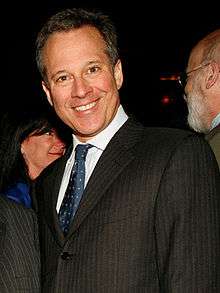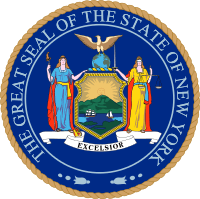Government of New York
The government of New York State, headquartered at the New York State Capitol in Albany, encompasses the administrative structure of the U.S. state of New York, as established by the New York State Constitution. Analogously to the United States federal government, it is composed of three branches: executive, legislative, and judicial. The head of the executive is the Governor, the Legislature consists of the Senate and the Assembly, and the Unified Court System consists of the Court of Appeals and lower courts. The state is also divided into counties, cities, towns, and villages, which are all municipal corporations with their own government.
Executive
The elected executive officers are:
|
There are several (limited to twenty[1]) state government departments:
- Department of Agriculture and Markets
- Department of Audit and Control
- Department of Civil Service
- Department of Corrections and Community Supervision The State Education Building in Albany
- Department of Economic Development
- Education Department
- Department of Environmental Conservation
- Executive Department
- Department of Family Assistance
- Department of Financial Services
- Department of Health
- Department of Labor
- Department of Law
- Department of Mental Hygiene
- Department of Motor Vehicles
- Department of Public Service
- Department of State
- Department of Taxation and Finance
- Department of Transportation
Regulations are promulgated and published in the New York State Register and compiled in the New York Codes, Rules and Regulations (NYCRR).[2] There are also numerous decisions, opinions, and rulings of state agencies.[3]
Legislature

The New York State Legislature is bicameral and consists of the New York State Senate and the New York State Assembly. The Assembly consists of 150 members; the Senate varies in its number of members, but currently has 63.[4] The Assembly is headed by the Speaker; the Senate is headed by the President, a post held ex officio by the Lieutenant Governor, who only has a tie-breaking "casting vote", but more often it is presided over by the Temporary President or by a senator of the Majority Leader's choosing.
The Legislature is empowered to make laws, subject to the Governor's power to veto a bill. However, the veto may be overridden by the Legislature if there is a two-thirds majority in favor of overriding in each House. Furthermore, it has the power to propose amendments to the New York Constitution by a majority vote and then another majority vote following an election. If so proposed, the amendment becomes valid if agreed to by the voters at a referendum. The session laws are published in the official Laws of New York.[5][6] The permanent laws of a general nature are codified in the Consolidated Laws of New York.[5][7]
Judiciary
The New York State Unified Court System interprets and applies the law of New York, ensures equal justice under law, and provides a mechanism for dispute resolution. The court system in New York tends to produce mild confusion for outsiders.[8][9] In general, the judicial system is composed of the trial courts, consisting of the superior courts and the local courts, and the appellate courts.[10]
The appellate courts are the:[10]
- Court of Appeals
- Appellate Division of the Supreme Court
- appellate terms of the Supreme Court
- appellate sessions of the County Court
The superior courts are the:[10]
- Supreme Court
- County Court
- specialized courts (Family Court, Surrogate's Court, Court of Claims)
And the inferior courts are the local courts:[10]
- District Court
- New York City courts (NYC Criminal Court, NYC Civil Court)
- city courts
- justice courts (town and village courts)
The highest court of appeal is the Court of Appeals (instead of the "Supreme Court") whereas the primary felony trial court is the County Court (or the Supreme Court in New York City). The Supreme Court also acts as the intermediate appellate court for many cases, and the local courts handle a variety of other matters and are the starting point for all criminal cases. The New York City courts make up the largest local court system. The system is administered by the Chief Judge of the Court of Appeals, also known as the Chief Judge of New York, the Chief Administrative Judge, the Office of Court Administration and other agencies.
Local government

The state is divided into counties, cities, towns, and villages, which are all municipal corporations with their own government that provide most local government services.[11] Whether a municipality is defined as a city, town, or village is not dependent on population or land area, but rather by the form of government selected by the residents and approved by the New York State Legislature.[12][13][14] Each such government is granted varying home rule powers as provided by the New York Constitution,[15] and a local law has a status equivalent with a law enacted by the Legislature (subject to certain exceptions and restrictions).[16] New York also has various corporate entities that serve single purposes that are also local governments, such as school and fire districts as well as New York state public-benefit corporations, frequently known as authorities or development corporations.[15] New York has 62 counties,[17][18] which are subdivided into 932 towns[14] and 62 cities;[13] it also has 10 Indian reservations.[19] In total, the state has over 3400 active local governments and over 4200 taxing jurisdictions.[20][21]
In 1898, when New York City was consolidated into its present form, all previous town and county governments within it were abolished in favor of the present five boroughs and unified, centralized city government (the New York City government).[22]
See also
References
- ↑ Constitution of the State of New York Article V, § 2.
- ↑ Gibson & Manz 2004, p. 218.
- ↑ Gibson & Manz 2004, pp. 235–253.
- ↑ McKinley, Jesse (February 24, 2014). "What Is a Majority Vote in the State Senate? The Answer Goes Beyond Simple Math". The New York Times.
- 1 2 Gibson & Manz 2004, p. 30.
- ↑ Gibson & Manz 2004, pp. 47–48.
- ↑ Gibson & Manz 2004, pp. 56–57.
- ↑ Kaye, Judith (February 8, 1999), The State of the Judiciary,
[...] absurdly complex [...] a court system that is difficult to understand, hard to navigate and a burden to administer.
- ↑ Ward, Robert B. (2006). New York State Government. Rockefeller Institute Press. pp. 140–141, 146. ISBN 978-1-930912-16-8. LCCN 2006050402.
- 1 2 3 4 Gibson & Manz 2004, p. 123.
- ↑ Gibson & Manz 2004, pp. 257–258.
- ↑ Local Government Handbook, p. 67.
- 1 2 Local Government Handbook, p. 51.
- 1 2 Local Government Handbook, p. 60.
- 1 2 Local Government Handbook, pp. 29–37.
- ↑ Adopting Local Laws in New York State (PDF). James A. Coon Local Government Technical Series. New York State Department of State. May 1998. pp. 3–10.
- ↑ Local Government Handbook, p. 39.
- ↑ Local Government Handbook, pp. 68–70.
- ↑ "Certificate of Individual Indian Exemption from State Taxes on Property or Services Delivered on a Reservation" (PDF). New York State Department of Taxation and Finance. Retrieved 2011-03-21.
- ↑ Individual State Descriptions: 2012 (PDF), 2012 Census of Governments, United States Census Bureau, September 2013, p. 203
- ↑ Governor Eliot Spitzer (2007). "Executive Order No. 11: Establishing the New York State Commission on Local Government Efficiency and Competitiveness." (PDF). State of New York. p. 1. Retrieved 2009-04-03.
- ↑ Local Government Handbook, p. 56.
- Local Government Handbook (PDF) (6th ed.). New York State Department of State. 2009.
- Gibson, Ellen M.; Manz, William H. (2004). Gibson's New York Legal Research Guide (PDF) (3rd ed.). Wm. S. Hein Publishing. ISBN 1-57588-728-2. LCCN 2004042477. OCLC 54455036.
Further reading
- Feldman, Daniel L.; Benjamin, Gerald (2010). Tales from the Sausage Factory: Making Laws in New York State. SUNY Press. ISBN 978-1-4384-3401-8.
- Pecorella, Robert F.; Stonecash, Jeffrey M. (2012). Governing New York State (6th ed.). SUNY Press. ISBN 978-1-4384-4473-4.
- Zimmerman, Joseph F. (2008). The Government and Politics of New York State (2nd ed.). SUNY Press. ISBN 978-0-7914-7435-8.





